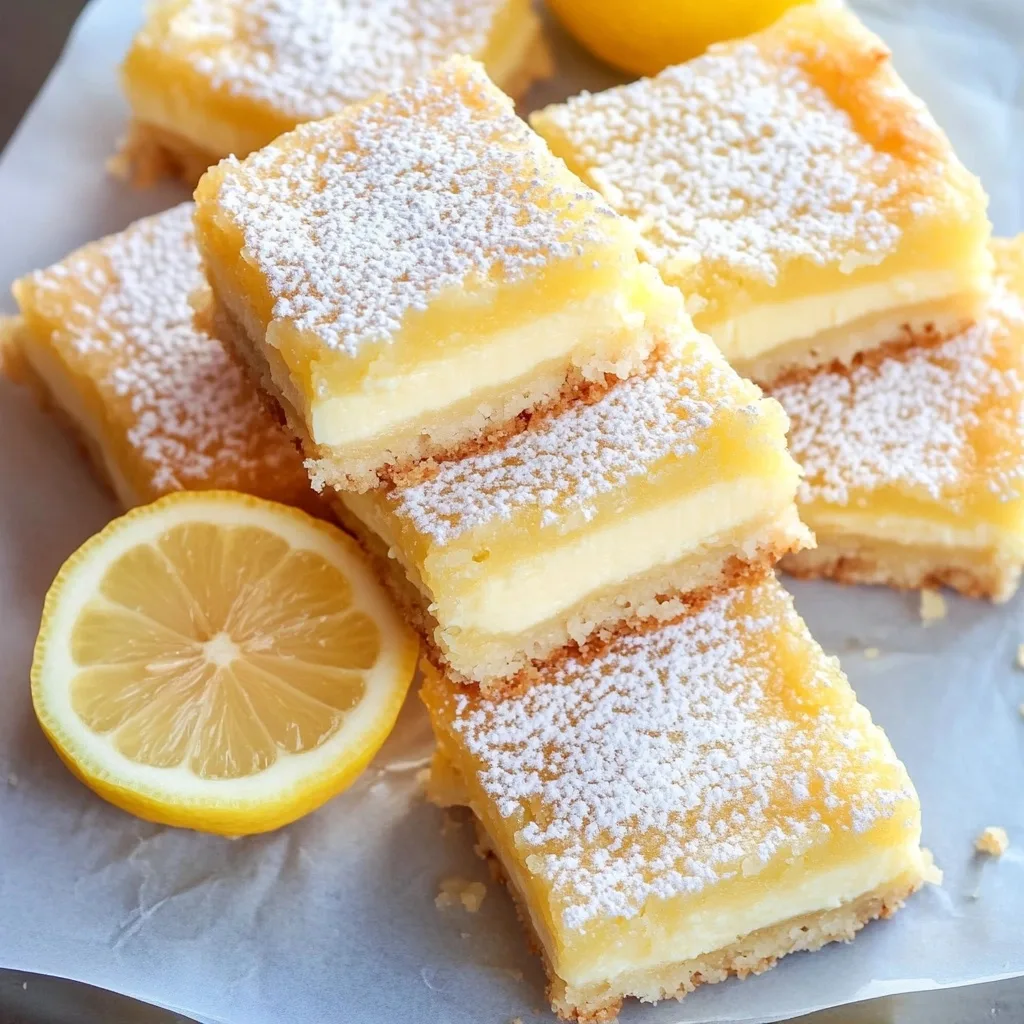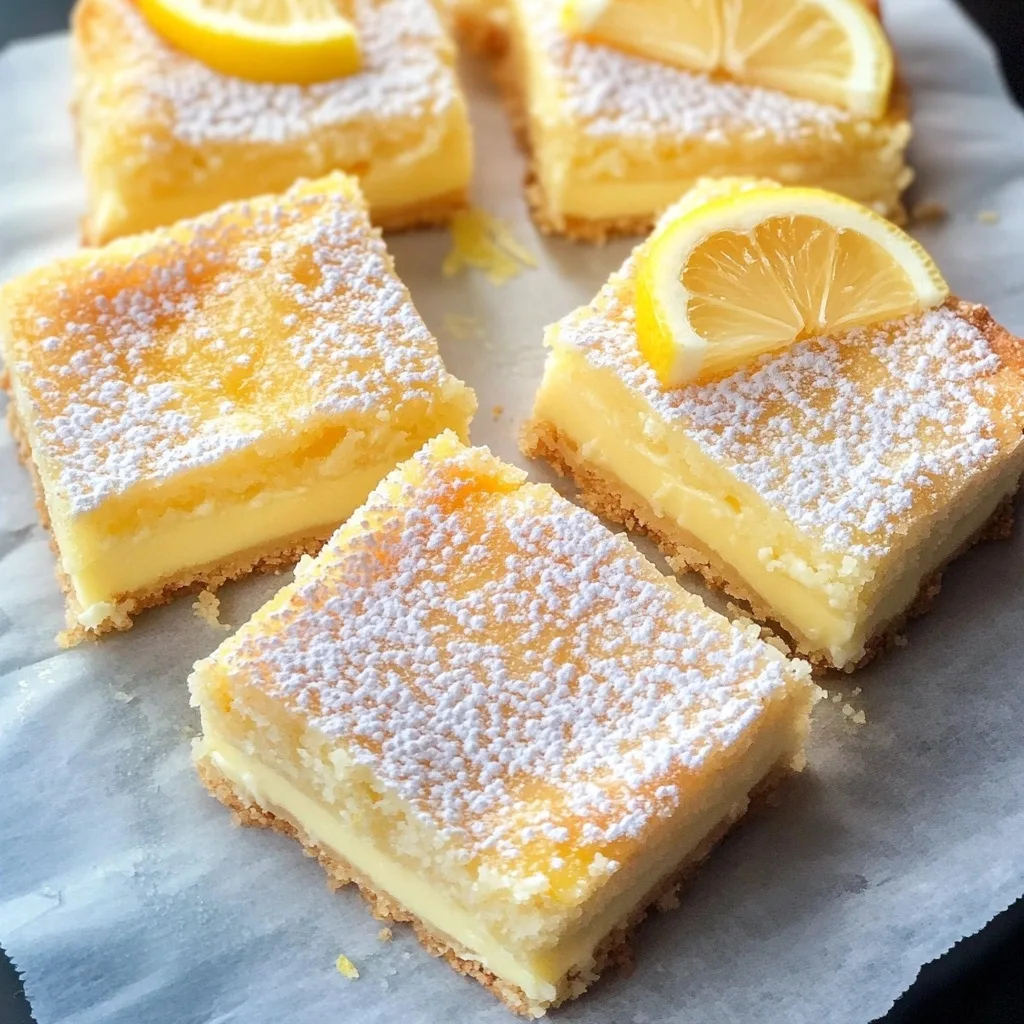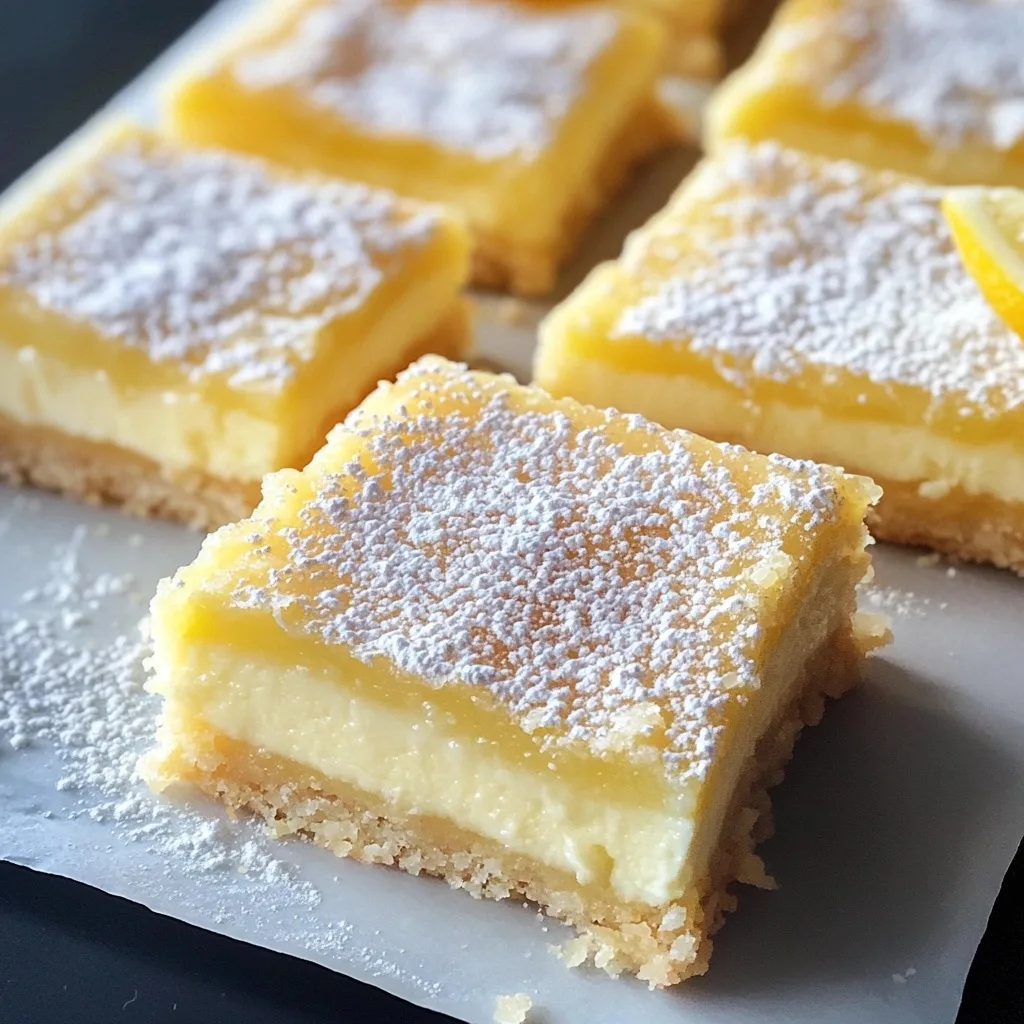Transform your ordinary dessert spread into something extraordinary with these Cream Cheese Lemon Bars. Featuring a buttery shortbread crust and a silky lemon-cream cheese filling, these bars deliver the perfect balance of citrusy brightness and creamy indulgence that will have everyone reaching for seconds!
Picture this: you bite into a dessert bar that’s simultaneously tangy and sweet, with a texture so creamy it melts on your tongue while delivering the zesty punch of fresh lemons. That’s exactly what you get with these Cream Cheese Lemon Bars – a dessert that combines the classic appeal of lemon bars with the luxurious creaminess of cheesecake.
Why You’ll Fall in Love with These Cream Cheese Lemon Bars
These aren’t your ordinary lemon bars. While traditional lemon bars can sometimes feel a bit one-dimensional with their focus purely on citrus, these Cream Cheese Lemon Bars bring a whole new level of complexity to the table. The cream cheese adds a velvety richness that perfectly balances the bright acidity of the lemon juice and zest.
What makes these bars truly special is their dual personality. On one hand, you have the sunshine-bright lemon flavor that makes your taste buds dance. On the other hand, there’s the sophisticated creaminess that gives these bars a cheesecake-like quality. It’s like getting two desserts in one – and who doesn’t love a dessert that works harder for your enjoyment?
The texture contrast is another reason these bars are absolutely irresistible. The shortbread crust provides a buttery, crumbly foundation that perfectly supports the smooth, almost pudding-like filling. Every bite delivers a satisfying contrast between the crisp crust and the silky filling, making these bars as texturally interesting as they are delicious.
From a practical standpoint, these Cream Cheese Lemon Bars are a baker’s dream. They can be made ahead of time (in fact, they’re better when chilled overnight), they slice cleanly into perfect portions, and they’re substantial enough to satisfy dessert cravings without being overly heavy. Whether you’re hosting a dinner party, bringing treats to a potluck, or just want something special for your family, these bars check all the boxes.
The Science Behind Perfect Cream Cheese Lemon Bars
Understanding the science behind these bars helps explain why they’re so consistently delicious. The cream cheese doesn’t just add flavor – it fundamentally changes the structure of the filling. While traditional lemon curd relies on eggs and butter for its texture, the cream cheese in these bars creates a more stable emulsion that holds up better to temperature changes and slicing.
The combination of lemon juice and cream cheese also creates a perfect pH balance. The acidity of the lemon juice reacts with the proteins in the cream cheese, creating a filling that sets properly without becoming too dense or too runny. This is why getting your measurements right is crucial – too little lemon juice, and the filling won’t set properly; too much, and it might become too tangy or even curdle.
The shortbread crust is another science success story. By incorporating cream cheese into the crust along with butter, you create a more tender, slightly cake-like base that complements the creamy filling perfectly. The cream cheese adds moisture and fat, resulting in a crust that’s sturdy enough to support the filling but tender enough to cut easily.
Temperature control plays a crucial role in these bars’ success. Room temperature ingredients blend more easily, creating a smoother filling. The initial baking of the crust at 350°F creates a barrier that prevents the filling from seeping through, while the lower temperature during the second baking phase allows the filling to set gently without cracking or over-browning.
Essential Ingredients: Building Blocks of Perfection
The beauty of these Cream Cheese Lemon Bars lies in their simplicity – just a handful of quality ingredients create something truly spectacular. Let’s break down what makes each component essential:
Unsalted Butter: The foundation of our shortbread crust, butter provides both flavor and structure. Using unsalted butter allows you to control the salt content precisely, while room temperature butter creams perfectly with the cream cheese and sugar.
Cream Cheese: The star of the show appears in both the crust and filling, adding richness and creating that signature creamy texture. Always use full-fat cream cheese for the best results – reduced-fat versions can make the texture grainy and the flavor less rich.
Fresh Lemons: Never, ever use bottled lemon juice for these bars. Fresh lemons provide both the juice and zest needed for maximum flavor impact. The oils in the zest add an intense lemon flavor that bottled juice simply can’t match.
Granulated Sugar: Provides sweetness and helps create the proper texture in both crust and filling. The sugar also helps the eggs in the filling create a stable custard-like structure.
All-Purpose Flour: Essential for both the crust and as a stabilizer in the filling. In the crust, it provides structure, while in the filling, it helps prevent curdling and creates a smoother texture.
Eggs: Fresh, large eggs are crucial for the filling’s structure. They provide the protein matrix that, combined with the cream cheese, creates that perfect set texture.
Powdered Sugar: For the final dusting that adds sweetness and creates that bakery-perfect appearance. Powdered sugar also helps mask any minor imperfections on the surface.
Salt: Just a pinch in both crust and filling enhances all the other flavors, making the lemon taste brighter and the sweetness more balanced.

Mastering the Shortbread Crust: Foundation of Excellence
The shortbread crust is more than just a foundation – it’s an integral part of the overall flavor and texture experience. Creating the perfect crust requires attention to detail and proper technique.
Start by bringing your butter and cream cheese to room temperature. This typically takes about 1-2 hours if left on the counter, or you can speed up the process by cutting the butter into cubes and breaking the cream cheese into smaller pieces. Room temperature ingredients cream together smoothly, ensuring your crust has a uniform texture without lumps.
When creaming the butter, cream cheese, and sugar, use a stand mixer if you have one, or a hand mixer with clean beaters. Beat for at least 2 minutes on medium speed – you want the mixture to become noticeably lighter in color and fluffy in texture. This incorporation of air creates a more tender crust.
Add the flour and salt gradually, mixing on low speed just until the dough comes together. Overmixing develops gluten, which leads to a tough crust. The dough should look slightly sandy and hold together when pressed – it won’t form a smooth ball like cookie dough, and that’s exactly right.
Pressing the dough into your prepared pan requires a gentle touch. Use your fingertips to press the dough evenly across the bottom, then use the back of a measuring cup to smooth it out and ensure even thickness. Pay special attention to the corners, where the crust tends to be thinner.
Pre-baking the crust is crucial for preventing a soggy bottom. Bake until the edges just start to turn golden – about 15-18 minutes. The center should still be quite pale. This partial baking creates a barrier that prevents the filling from seeping into the crust while still allowing the crust to finish baking with the filling on top.
Creating the Silky Lemon-Cream Filling
The filling is where the magic happens, transforming simple ingredients into something sublime. The key to a perfectly smooth, creamy filling lies in proper preparation and technique.
Start with room temperature cream cheese – this is non-negotiable. Cold cream cheese creates lumps that are nearly impossible to smooth out completely. If you’re pressed for time, cut the cream cheese into cubes and microwave for 10-15 seconds, checking and stirring frequently.
Beat the cream cheese and sugar until completely smooth before adding any other ingredients. This takes about 2-3 minutes with a hand mixer or 1-2 minutes with a stand mixer. You want no visible lumps and a noticeably lighter, airier texture.
Add eggs one at a time, beating well after each addition. This gradual incorporation prevents the eggs from scrambling and ensures a smooth, homogeneous filling. Each egg should be fully incorporated before adding the next.
When adding the lemon juice, add it slowly with the mixer running on low speed. Lemon juice can cause cream cheese to curdle if added too quickly. The filling should remain smooth throughout this process.
The tablespoon of flour isn’t just a filler – it’s insurance against a runny filling. It helps absorb excess moisture and creates a more stable structure. Mix it in thoroughly but don’t overbeat once the flour is added.
The lemon zest should be added last, folded in gently to preserve its bright, fresh flavor. Zest your lemons just before using to capture the maximum amount of essential oils.
The finished filling should be completely smooth, with a consistency similar to heavy cream. It should coat the back of a spoon but still pour easily. If you notice any lumps, strain the filling through a fine-mesh sieve before pouring it over the crust.
Pour the filling over the hot crust (this helps it adhere better) and gently tap the pan on the counter a few times to remove any air bubbles. Use an offset spatula to spread the filling evenly to the edges.
Baking Techniques for Bakery-Perfect Results
The baking process for these Cream Cheese Lemon Bars requires precision and patience, but the results are worth every minute of attention.
After assembling your bars, return the pan to the preheated 350°F oven immediately. This consistent temperature is crucial for proper setting. The filling needs 20-25 minutes of baking time, but the exact timing depends on several factors including your oven’s accuracy and the depth of your filling.
Watch for visual cues rather than relying solely on the timer. The filling is done when the edges are set but the center still has a slight jiggle – similar to a cheesecake. The surface should look matte rather than shiny, and it shouldn’t ripple when you gently shake the pan.
Avoid overbaking, which can cause the filling to crack or become grainy. Remember that carryover cooking will continue to set the filling as it cools, so it’s better to err slightly on the underbaked side.
Remove the pan from the oven and place it on a wire cooling rack. This allows air circulation underneath the pan, promoting even cooling and preventing condensation on the bottom of the crust.
Let the bars cool at room temperature for exactly 30 minutes. This initial cooling period allows the filling to begin setting while still being warm enough to finish the baking process. Too rapid cooling can cause cracks, while insufficient cooling can lead to a runny filling.
After 30 minutes, transfer the entire pan to the refrigerator. The chilling process is essential – it’s not just about serving cold bars. The filling needs this time to fully set into that perfect, sliceable consistency. A minimum of 2 hours is required, but overnight chilling produces the cleanest slices.
When you’re ready to serve, remove the pan from the refrigerator and let it sit at room temperature for 10-15 minutes. This slight warming makes the bars easier to cut and brings out the flavors more fully.
Achieving the Perfect Slice: Pro Tips and Techniques
One of the most satisfying aspects of making these Cream Cheese Lemon Bars is cutting them into perfect, clean slices. Here’s how to achieve bakery-quality presentation every time.
Start with a sharp, thin knife – a chef’s knife or a large paring knife works well. Wipe the blade clean and dry it between cuts to prevent the filling from smearing and to ensure each cut is clean.
If you lined your pan with parchment paper, use the overhang to lift the entire slab out onto a cutting board. This makes cutting much easier and protects your pan from knife scratches.
For the cleanest cuts, dip your knife in hot water and dry it with a paper towel before each cut. The heat helps the knife glide through the chilled filling more easily. Some professionals even use unflavored dental floss for extra-clean cuts.
Score the surface lightly with a knife to mark your cutting lines before making full cuts. This ensures even portions and straight lines. For standard serving sizes, a 9×9 pan typically yields 16 squares (4×4 grid) or 12 rectangles (3×4 grid).
When dusting with powdered sugar, do so just before serving. Powdered sugar tends to absorb moisture and disappear into the surface over time. Use a fine-mesh sieve for even distribution and dust generously – you want a substantial coating that won’t disappear at first bite.
For an extra-special presentation, cut a few lemons into paper-thin slices and place one on top of each bar, or add a small twist of lemon peel. A few fresh berries or a small mint leaf can also elevate the presentation.
Store cut bars in an airtight container in the refrigerator, placing parchment paper between layers to prevent sticking. These bars actually improve with a day or two of aging, as the flavors meld and the texture becomes even more creamy.

Variations and Flavor Combinations
While the classic Cream Cheese Lemon Bars are perfection in themselves, there are numerous ways to customize this recipe to suit different tastes and occasions.
Berry Swirl Variation: Before baking the filling, create a quick berry puree by blending ½ cup fresh or frozen berries with 1 tablespoon sugar. Dollop this puree over the filling and swirl with a knife for a beautiful marbled effect and bursts of berry flavor.
Key Lime Version: Substitute fresh key lime juice and zest for the lemon. You’ll need about 8-10 key limes to get ⅓ cup juice. The smaller, more intense key limes create a different but equally delicious flavor profile.
Meyer Lemon Upgrade: Meyer lemons are sweeter and less acidic than regular lemons. If using Meyer lemons, reduce the sugar in the filling by 2 tablespoons to maintain the perfect sweet-tart balance.
Lavender-Lemon Fusion: Add 1 teaspoon of culinary-grade dried lavender to the crust mixture and a few drops of pure lavender extract to the filling. This creates an sophisticated, spa-like dessert perfect for spring and summer gatherings.
Coconut Cream Cheese Bars: Add 1 teaspoon coconut extract to the filling and fold in ½ cup sweetened shredded coconut. Sprinkle toasted coconut on top before serving for a tropical twist.
Graham Cracker Crust: Replace the shortbread crust with a graham cracker crust for a more traditional cheesecake base. Mix 1½ cups graham cracker crumbs with ⅓ cup melted butter and 2 tablespoons sugar.
Ginger-Lemon Combination: Add 1 tablespoon grated fresh ginger to the filling and incorporate crushed gingersnap cookies into the crust for a spicy-sweet variation that’s especially popular during the holidays.
Storage, Make-Ahead, and Gift-Giving Tips
These Cream Cheese Lemon Bars are ideal for advance preparation and make wonderful gifts when presented properly.
Proper Storage: Store completely cooled and cut bars in an airtight container in the refrigerator for up to 5 days. Layer bars between sheets of parchment paper to prevent them from sticking together. The bars can also be frozen for up to 2 months, though the texture may be slightly softer after thawing.
Make-Ahead Strategy: These bars actually taste better when made 1-2 days in advance. The flavors have time to meld, and the texture becomes even more cohesive. Prepare the bars completely, chill overnight, then cut and dust with powdered sugar the next day.
Gift Presentation: For gift-giving, place individual bars in clear cellophane bags tied with ribbon, or arrange several bars in a decorative tin lined with parchment paper. Include a note mentioning they should be kept refrigerated.
Transportation Tips: When taking these bars to events, keep them chilled until the last moment. Use insulated carriers with ice packs during transport. If you must dust with powdered sugar beforehand, keep extra sugar with you for touch-ups before serving.
Scaling the Recipe: This recipe doubles easily for larger gatherings. Use a 9×13 inch pan and increase baking time by 5-7 minutes. For half batches, use an 8×8 inch pan and reduce baking time by 3-5 minutes.
Nutritional Benefits and Serving Suggestions
While these Cream Cheese Lemon Bars are undeniably a dessert, they do offer some nutritional benefits worth noting.
Vitamin C Boost: Fresh lemon juice provides a significant amount of vitamin C, with one lemon containing about 50% of the daily recommended value. Vitamin C is essential for immune function and iron absorption.
Calcium Content: The cream cheese and dairy ingredients provide calcium, important for bone health. Each serving contains approximately 80-100mg of calcium.
Protein Source: The eggs and cream cheese contribute protein, making these bars more satisfying than purely sugar-based desserts. Each serving contains about 4-5 grams of protein.
Mindful Serving Sizes: While rich and indulgent, these bars are portion-controlled by nature. A standard serving (1/16 of a 9×9 pan) provides about 200-250 calories, allowing you to enjoy dessert without overindulging.
Pairing Suggestions: Serve with fresh berries to add fiber and antioxidants. A small dollop of Greek yogurt can add protein and probiotics while cutting the richness slightly. For a more sophisticated presentation, serve with a small glass of limoncello or prosecco for adults, or lemon sparkling water for all ages.
Troubleshooting Common Issues
Even experienced bakers sometimes encounter challenges with cream cheese bars. Here are solutions to common problems:
Cracked Top: Usually caused by overbaking or rapid temperature changes. Prevent by baking just until the center jiggles slightly and cooling gradually.
Runny Filling: Underbaking is the typical culprit. Return to oven for 5-minute intervals until properly set, or chill longer for firmer texture.
Grainy Texture: This occurs when cream cheese isn’t properly softened or when ingredients are at different temperatures. Always use room temperature ingredients and beat thoroughly.
Soggy Crust: Results from underbaking the crust or a filling that was too liquid. Ensure the crust is set before adding filling and strain any lumpy filling.
Difficult Cutting: Ensure bars are well-chilled and use a hot, clean knife between cuts. Some find dental floss helpful for super-clean cuts.
Lemon Flavor Too Mild: Increase the lemon zest or add a few drops of lemon extract. Remember that flavors meld and intensify during chilling.
Too Sweet or Too Tart: Adjust the sugar levels in the filling up or down by 1-2 tablespoons to suit your taste preference. Keep notes for next time.

Perfect Occasions for Cream Cheese Lemon Bars
These versatile bars fit seamlessly into numerous occasions and celebrations:
Spring and Summer Events: Their bright, citrusy flavor makes them perfect for Easter brunch, Mother’s Day celebration, spring baby showers, garden parties, and summer potlucks.
Elegant Gatherings: Cut into petite squares and served on decorative plates, these bars elevate afternoon tea, book club meetings, bridal showers, and wine tastings.
Casual Occasions: Their make-ahead nature and easy transportability make them ideal for picnics, school events, office parties, and casual dinner parties.
Holiday Alternatives: For those wanting something different from traditional holiday sweets, these bars provide a refreshing alternative at Christmas and Thanksgiving.
Breakfast and Brunch: Serve small portions at breakfast or brunch alongside coffee and fresh fruit for a special morning treat.
Gift-Giving: Whether for new neighbors, host gifts, or thank-you presents, these bars are always well-received and show thoughtfulness and effort.
Historical Context and Cultural Significance
The evolution of lemon bars tells a fascinating story of American baking. Traditional lemon bars date back to the 1960s, but the addition of cream cheese represents a more recent innovation that bridges the gap between classic lemon bars and New York-style cheesecake.
This fusion reflects broader trends in American dessert culture, where traditional recipes are continuously updated to incorporate new flavors and techniques. The cream cheese addition not only improves texture but also makes the bars more stable for serving and transport – a crucial factor in America’s potluck culture.
The bright yellow color and tangy flavor of lemon have long symbolized freshness and renewal in many cultures, making these bars particularly popular for spring celebrations and new beginnings. The addition of cream cheese adds a layer of indulgence that speaks to our collective appreciation for comfort foods elevated to special-occasion status.
Cream Cheese Lemon Bars Around the World
While this particular style of lemon bar is distinctly American, variations exist in cuisines worldwide:
British Lemon Drizzle Cake: Similar citrus-forward dessert but in cake form with a syrup topping.
Italian Crostata al Limone: A tart with pastry crust and creamy lemon filling, often incorporating ricotta instead of cream cheese.
French Tarte au Citron: Features a buttery pastry crust with a lighter, egg-based lemon curd filling.
Japanese Lemon Cheesecake: Often lighter and less sweet than American versions, sometimes incorporating local ingredients like yuzu.
Mediterranean Variations: Often include local ingredients like honey, regional citrus varieties, or herbal elements like lavender or rosemary.
These global variations remind us that while the specific combination of cream cheese and lemon in bar form may be uniquely American, the love for citrus desserts spans cultures worldwide.
Conclusion: Why These Bars Deserve a Place in Your Recipe Collection
These Cream Cheese Lemon Bars represent the perfect marriage of simplicity and sophistication. They’re accessible enough for novice bakers yet impressive enough for experienced pastry chefs. The combination of bright citrus and rich cream cheese creates a dessert that’s both nostalgic and contemporary, comforting yet elegant.
Whether you’re looking for the perfect dessert to cap off a dinner party, a make-ahead treat for a special occasion, or simply want to brighten someone’s day with a homemade gift, these bars deliver consistently excellent results. The recipe’s versatility allows for seasonal variations and personal touches, while the core combination of flavors remains timelessly appealing.
Most importantly, these bars bring joy. There’s something universally uplifting about the combination of sweet, tart, and creamy that transcends age, culture, and personal preferences. In a world where desserts can be overly complicated or cloyingly sweet, these Cream Cheese Lemon Bars offer a refreshing alternative that celebrates quality ingredients, proper technique, and the simple pleasure of a perfectly balanced bite.
More Related Recipes You Might Enjoy
If you loved these Cream Cheese Lemon Bars, you’ll definitely want to try these other delightful dessert recipes:
Churros Poppers – These bite-sized churros poppers deliver all the crispy, cinnamon-sugar goodness of traditional churros in a fun, poppable format that’s perfect for parties and gatherings.
Paula Deen’s 5 Minute Fudge – When you need a quick dessert fix, this incredibly easy fudge comes together in just five minutes and delivers rich, chocolatey satisfaction that pairs wonderfully with the bright citrus flavors of lemon bars.
Peach Berry Fruit Salad – Balance out the richness of cream cheese bars with this fresh, vibrant fruit salad that combines sweet peaches and tart berries for the perfect palate cleanser.
These recipes complement the Cream Cheese Lemon Bars perfectly, offering a range of flavors and textures that can create a complete dessert spread for any occasion. Each recipe shares the quality of being both delicious and approachable, making them ideal additions to your dessert repertoire.
Print
Cream Cheese Lemon Bars | Ultimate Beginner’s Recipe Guide
- Total Time: 3 hours (including chilling)
- Yield: 16 bars 1x
- Diet: Vegetarian
Description
Transform your ordinary dessert spread into something extraordinary with these Cream Cheese Lemon Bars. Featuring a buttery shortbread crust and a silky lemon-cream cheese filling, these bars deliver the perfect balance of citrusy brightness and creamy indulgence that will have everyone reaching for seconds!
Ingredients
For the Crust:
- 1 cup (2 sticks) unsalted butter, room temperature
- 4 oz cream cheese, softened
- ½ cup granulated sugar
- 2 cups all-purpose flour
- Pinch of salt
For the Filling:
- 8 oz cream cheese, softened
- 1 cup granulated sugar
- 2 large eggs
- ⅓ cup freshly squeezed lemon juice (about 2 medium lemons)
- 1 tablespoon lemon zest (reserve extra for garnish if you like)
- 1 tablespoon all-purpose flour
- Pinch of salt
For Dusting:
- Powdered sugar, for sprinkling
Instructions
- Preheat & Prep: Preheat your oven to 350°F (175°C). Line a 9×9-inch baking pan with foil or parchment, leaving a bit of overhang to lift the bars out easily later. Give it a quick spray with nonstick cooking spray.
- Make the Shortbread Crust: In a large bowl, cream together the butter, cream cheese, and sugar until smooth and fluffy—about 2 minutes with a stand mixer or 3–4 with a hand mixer. Add the flour and salt, mixing on low until the dough just comes together. It’ll be soft and a bit sandy. Press that dough evenly into the bottom of your prepared pan, using the back of a measuring cup to smooth it out into every corner.
- Bake the Crust: Pop the pan in the oven and bake for 15–18 minutes, or until the edges are just starting to turn a light golden brown. Meanwhile, let’s make that dreamy filling!
- Whip Up the Lemon-Cream Filling: In a clean bowl, beat the 8 oz cream cheese and sugar together until silky—no lumps! Add the eggs one at a time, mixing until each is fully incorporated. Stir in the lemon juice, lemon zest, flour, and a pinch of salt. Mix just until smooth and shiny.
- Assemble & Bake: Pour the lemon-cream cheese filling over your hot crust, spreading it gently to the edges. Return the pan to the oven and bake for another 20–25 minutes. You want the center to be almost set—it’ll continue to firm up as it cools.
- Cool & Chill: Remove from the oven and set on a wire rack. After 30 minutes at room temp, transfer the bars (still in pan) to the fridge and chill at least 2 hours, or overnight for neatest slices.
- Slice & Serve: Use the foil/parchment “handles” to lift the slab out. Dust generously with powdered sugar, slice into squares or bars, and garnish with extra lemon zest or a thin lemon wheel if you’re feeling fancy.
Notes
- Always use room temperature ingredients for the smoothest texture
- Fresh lemon juice is essential – avoid bottled juice
- These bars taste even better after chilling overnight
- Can be made up to 2 days ahead of time
- Store covered in the refrigerator for up to 5 days
- Prep Time: 20 minutes
- Cook Time: 40 minutes
- Category: Dessert
- Method: Baking
- Cuisine: American
Nutrition
- Serving Size: 1 bar
- Calories: 245
- Sugar: 24g
- Sodium: 85mg
- Fat: 15g
- Saturated Fat: 9g
- Unsaturated Fat: 6g
- Trans Fat: 0g
- Carbohydrates: 26g
- Fiber: 0.5g
- Protein: 4g
- Cholesterol: 75mg

